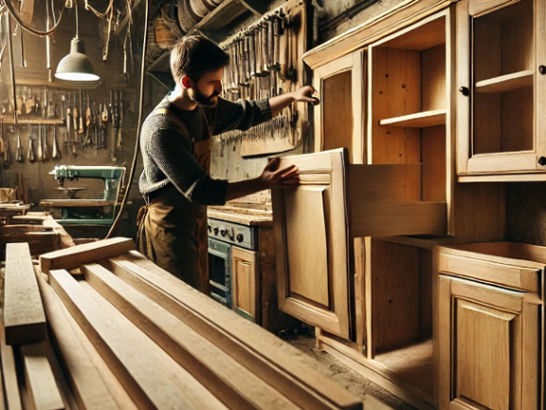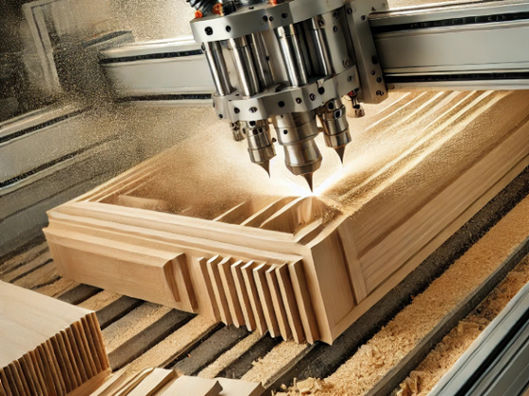Kitchen cabinets are the backbone of any well-organized kitchen, offering functionality and style. Whether you’re renovating your home or just curious about how these essential pieces come to life, this guide will take you through the step-by-step process of how kitchen cabinets are made.
We will also cover expert tips and essential factors to consider when choosing kitchen cabinets.
Step 1: Choosing the Right Materials
The initial and most important step in creating kitchen cabinets is the selection of the right materials. You have a few options, each with its pros and cons:
- Solid Wood – Durable and timeless in their beauty, but costly.
- Plywood – Inexpensive and lightweight but robust.
- MDF (Medium-Density Fibreboard) – Ideal for painted cabinets due to its smooth finish.
- Particle Board – The cheapest but less durable.
- Thermofoil – A heat-wrapped plastic wrap covering MDF that is durable, moisture-resistant, and stain-resistant.
- Stainless Steel – Luxury, contemporary, and widely used in commercial spaces.
Tip: Always choose moisture-resistant materials to prevent warping over time.
Step 2: Cutting and Shaping the Wood
After the materials have been chosen, they are cut into exact shapes using advanced wooden tools. Factories and workshops utilize high-tech CNC (Computer Numerical Control) machines to ensure precision and efficiency. Traditional carpenters, however, may still employ manual saws and routers for custom cabinets.
Common Components Cut During This Process:
- Cabinet panels (sides, top, and bottom)
- Doors and drawer fronts
- Shelving units
- Back panels and face frames
- Toe kicks and crown moldings for aesthetic detailing
Pro Tip: Investing in high-quality cuts ensures seamless cabinet assembly.
Step 3: Assembling the Cabinet Structure
After cutting, the next step is assembly. The cabinet pieces are put together using various techniques, including:
- Dovetail Joints – A traditional, sturdy joinery method.
- Pocket Screws – Quick and efficient, commonly used in modern cabinets.
- Glue and Clamps – For seamless, strong bonding.
- Cam Lock Fasteners – Popular in flat-pack furniture for easy assembly.
Once assembled, the cabinet frame takes shape, setting the foundation for additional features like drawers and shelves.
Step 4: Sanding and Finishing

To achieve a smooth and polished look, the cabinets are sanded to remove rough edges. This step is crucial for painted cabinets, as it ensures an even application of paint or stain. Finishing options include:
- Paint – Provides a modern, sleek appearance.
- Staining – Enhances the natural beauty of the wood grain.
- Laminate – A budget-friendly option for easy maintenance.
- Glazing – Adds depth and dimension to the cabinet finish.
- UV Curing – A high-tech finish that improves scratch resistance.
Fact: High-quality finishes improve longevity and resistance to moisture and heat.
Step 5: Adding Doors, Drawers, and Hardware
Once the structure is ready, it’s time to install the doors, drawers, and hardware. This is where the style and functionality come together. Key components include:
- Hinges – Soft-close hinges are popular for a noiseless experience.
- Handles & Knobs – Available in different styles, from classic brass to modern stainless steel.
- Drawer Slides – Ball-bearing slides offer smooth movement.
- Push-to-Open Mechanisms – Ideal for a handle-free, sleek design.
Proper alignment of these elements is essential to ensure kitchen cabinets function effortlessly.
Step 6: Final Inspection and Quality Control
Before installation, every kitchen cabinet goes through a quality check. Inspectors look for defects, ensuring that:
- The paint/stain is evenly applied.
- Drawers and doors open smoothly.
- The structure is sturdy and aligned correctly.
- Hardware is securely fastened.
Checklist: Always verify cabinet durability before final installation.
Step 7: Installation in Your Kitchen
The final step is installing the cabinets in your kitchen. Professional installers ensure that everything fits perfectly, using spirit levels and measuring tools to secure cabinets in place.
Key Steps in Installation:
- Measuring the space to fit correctly.
- Fixing base cabinets first, followed by wall cabinets.
- Aligning doors and drawers for a seamless appearance.
- Applying finishing touches such as trim and molding.
- Providing proper ventilation if close to appliances
Once installed, your kitchen cabinets are ready for use, bringing beauty and functionality to your space!
Different Types of Kitchen Cabinets
Stock Cabinets
These are mass-produced cabinets in standard sizes and styles. They are budget-friendly but with limited customization options.
Semi-Custom Cabinets
A middle-of-the-road solution that provides some customization, including materials, finishes, and design adjustments.
Custom Cabinets
Fully customized cabinets to specific kitchen sizes and design preferences. These are the most expensive but offer unmatched quality and personalization.
Frameless vs. Framed Cabinets
- Frameless Cabinets: Sleek, modern, with no face frame, offering more accessible storage.
- Framed Cabinets: Classic, with added strength and decorative beauty.
FAQs About Kitchen Cabinets

How long does it take to build kitchen cabinets?
It depends on whether they are custom-built cabinets (4–6 weeks) or pre-assembled cabinets (1–2 weeks).
What is the best wood for kitchen cabinets?
Hardwoods like oak, maple, and cherry are perfect for durability, while MDF is perfect for a smooth painted finish.
How much do kitchen cabinets cost?
Prices vary based on material and style. On average:
- Stock cabinets: £100 – £500 per unit
- Semi-custom cabinets: £500 – £1,500 per unit
- Custom cabinets: £2,000+ per unit
How do I maintain my kitchen cabinets?
- Clean with mild detergent and soft cloth.
- Refrain from excessive moisture and heat exposure.
- Use cabinet liners to guard against spills on shelves.
- Inspect and tighten hardware regularly to avoid loosening.
Final Thoughts
Understanding how kitchen cabinets are made gives you insight into their durability, quality, and design. Whether you prefer custom-built cabinets or mass-produced options, knowing the process helps you make informed decisions when renovating your kitchen.
Next Steps: Bookmark this guide for reference and share it with friends planning a kitchen makeover!